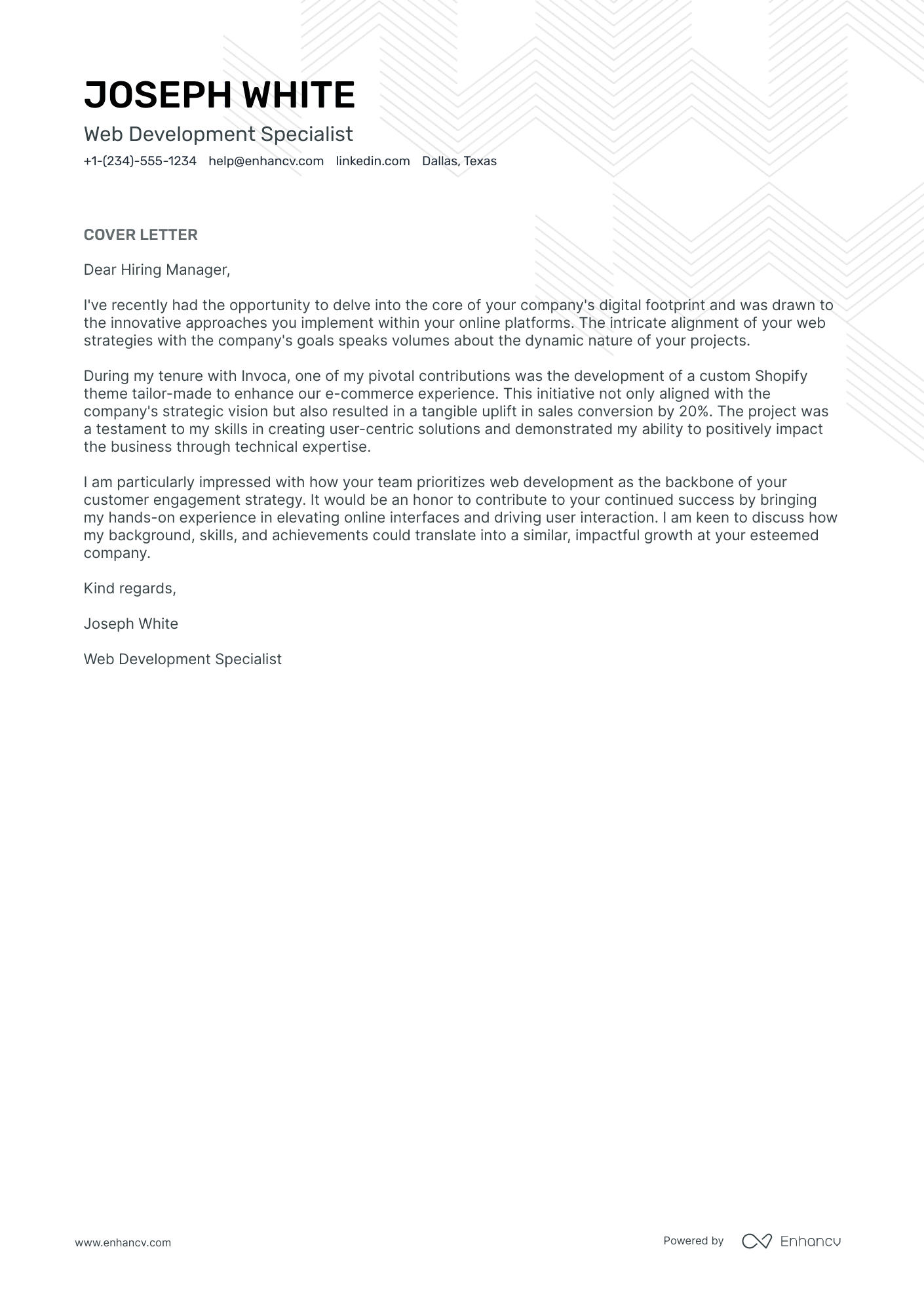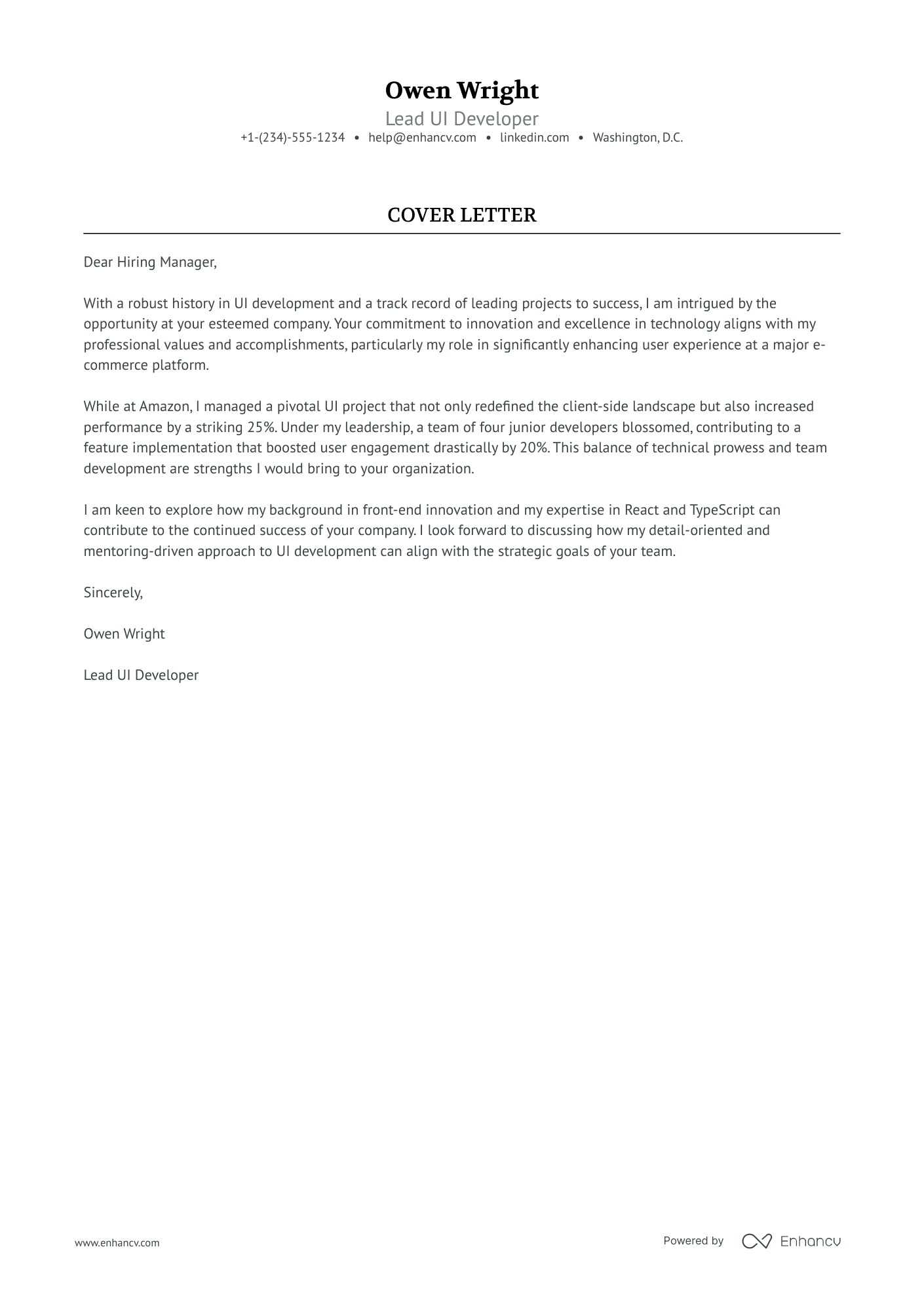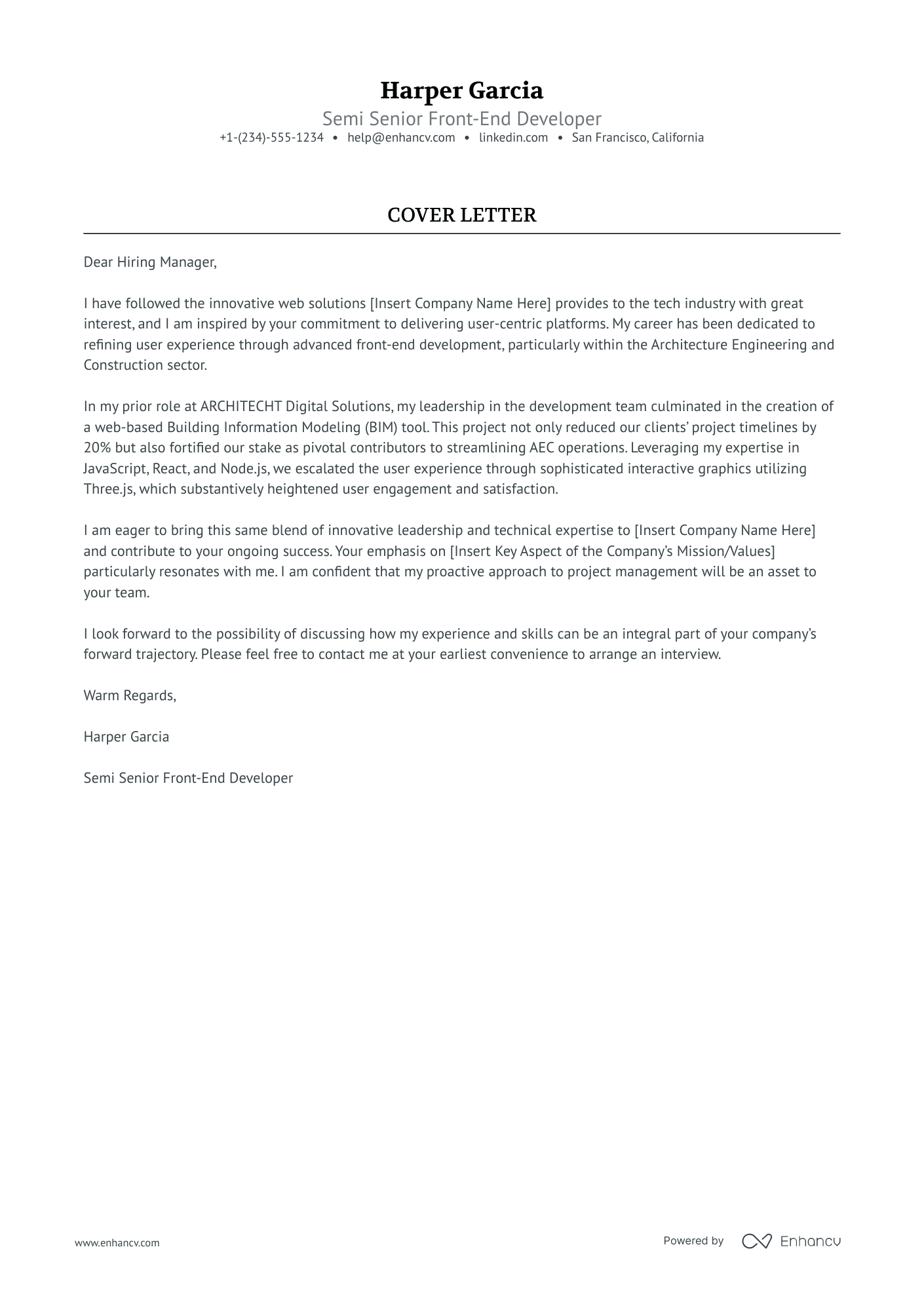Crafting a front-end developer cover letter can often be a puzzling step in your job search. You've polished your resume, started applying, and now realize a compelling cover letter is a must. Yet, it's crucial to weave a narrative around a standout professional achievement without echoing your resume. Strike a balance between formality and authenticity, dodging worn-out phrases. And remember, brevity is key: your story must unfold on just one page.
- Personalize your front end developer cover letter and get inspired by other professionals to tell a compelling story;
- Format and design your front end developer cover letter to make an excellent first impression;
- Introduce your best achievement in your front end developer cover letter to recruiters;
- How to make sure recruiters get in touch with you, using your front end developer cover letter greeting and closing paragraphs.
What is more, did you know that Enhancv's AI can write your cover letter for you? Just upload your front end developer resume and get ready to forward your job application in a flash.
If the front end developer isn't exactly the one you're looking for we have a plethora of cover letter examples for jobs like this one:
Drop your resume here or choose a file.
PDF & DOCX only. Max 2MB file size.
Front end developer cover letter example
MARC O'DONELL
New York, NY
+1-(234)-555-1234
help@enhancv.com
- Highlighting measurable achievements: The cover letter mentions leading the development and maintenance of high-traffic websites and improving conversion rates, providing concrete evidence of success.
- Emphasizing relevant skills: It specifically outlines experience in front-end development, an essential skill for the role, and leadership—key for collaborative projects.
- Discussing impact and problem-solving: The candidate showcases an instance of identifying and implementing a solution that resulted in a significant reduction in page load times, demonstrating their ability to solve real-world problems that directly affect business performance.
- Expressing cultural fit and enthusiasm: The cover letter reflects the candidate's knowledge of the company’s work culture and projects, showing genuine interest and the likelihood of being a good fit for the team.
The must-have sections and format of your front end developer cover letter
When writing your front end developer cover letter, keep in mind that it'll only be read by the recruiters and not the Applicant Tracker System (or software used to assess your profile). That's why you should structure your content with a/an:
- Header (apart from your contact information, include your name, the role you're applying for, and the date);
- Personalized salutation;
- Opening paragraph to win the recruiters over;
- Middle paragraph with key details;
- Closing that starts from clichés;
- Sign off (that's not mandatory).
Industry standards dictate your paragraphs to be single-spaced and to wrap your content in a one-inch margin. Designing your front end developer cover letter, refer to one of our templates, which automatically takes care of the spacing and margins.
Choose the same font for your front end developer cover letter as you did for your resume: the likes of Lato and Bitter would help you to stand out in a sea of cover letters in Arial or Times New Roman.
Export your whole front end developer cover letter from our builder in PDF to keep the same formatting and image quality.
Don’t stress about writing your cover letter. Use our free cover letter generator to make one in seconds.
The top sections on a front end developer cover letter
- Header: Include your contact information, the date, and the employer's contact information to ensure the hiring manager can easily see who the letter is from and how to contact you.
- Greeting: Address the hiring manager or recruitment team by name if possible, as it demonstrates that you've done your research and are personally interested in the company and the role.
- Introduction: Clearly state the front-end developer position you are applying for and express your enthusiasm for the role, as this sets the tone for your interest and suitability.
- Professional Experience and Technical Skills: Highlight your relevant coding skills, projects, and experiences that directly relate to the front-end development job, emphasizing your proficiency with HTML, CSS, JavaScript, and any frameworks or libraries you are familiar with.
- Closing and Call to Action: Reinforce your interest in becoming part of the team, invite the hiring manager to review your portfolio or GitHub repository for code samples, and suggest a follow-up call or meeting to discuss your application further.
Key qualities recruiters search for in a candidate’s cover letter
Proficiency in HTML, CSS, and JavaScript: Recruiters look for a strong foundation in these core frontend technologies, as they form the backbone of web development and are essential for creating interactive and responsive web designs.
Experience with modern JavaScript frameworks/libraries (e.g., React, Vue.js, Angular): Knowledge of these tools is important because they help developers build complex applications more efficiently and are widely used in the industry.
Responsive and mobile-first design skills: With the increasing use of mobile devices, the ability to create websites that look good and function well on all screen sizes is crucial for a frontend developer.
Understanding of web performance optimization: Recruiters value developers who can write efficient code and use best practices to minimize page load times and enhance user experience.
Familiarity with version control (Git): Version control is essential for collaborating on projects, maintaining code quality, and tracking changes over time, making it a vital skill for any development role.
Strong portfolio showcasing design and development projects: A portfolio provides tangible proof of a developer's skills and style, and allows recruiters to assess their capability to build functional, attractive, and user-centered interfaces.
Kick off your front end developer cover letter: the salutation or greeting
When writing your front end developer cover letter, remember that you're not writing for some complex AI or robot, but for actual human beings.
And recruiters, while on the lookout to understand your experience, would enjoy seeing a cover letter that is tailored to the role and addresses them. Personally.
So, if you haven't done so, invest some time in finding out who's the hiring manager for the role you're applying to. A good place to start would be LinkedIn and the corporate website.
Alternatively, you could also get in touch with the company to find out more information about the role and the name of the recruiter.
If you haven't met the hiring manager, yet, your front end developer cover letter salutation should be on a last-name basis (e.g. "Dear Mr. Donaldson" or "Dear Ms. Estephan").
A good old, "Dear HR Professional" (or something along those lines) could work as your last resort if you're struggling to find out the recruiter's name.
List of salutations you can use
- Dear Hiring Manager,
- Dear [Company Name] Team,
- Dear [Department Name] Director,
- Dear [Mr./Ms./Dr.] [Last Name],
- Dear [Job Title] Search Committee,
Your front end developer cover letter introduction and the value you bring
Moving on from the "Dear Recruiter" to your professional introduction.
Use those first two sentences of your front end developer cover letter to present the biggest asset you'd bring to the organization.
Don't go into too much detail about your achievement or the skill set, but instead - go straight for the win.
That is - what is your value as a professional?
Would you be able to build stronger, professional relationships in any type of communication? Or, potentially, integrate seamlessly into the team?
How to write an achievement-focused front end developer cover letter body
We've got the intro and greeting covered. Now, comes the most definitive part of your front end developer cover letter - the body.
In the next three to six paragraphs, you'd have to answer why should recruiters hire you.
What better way to do this than by storytelling?
And, no, you don't need a "Once upon a time" or "I started from the bottom and made it to the top" career-climbing format to tell a compelling narrative.
Instead, select up to three most relevant skills for the job and look back on your resume.
Find an achievement, that you're proud of, which has taught you these three job-crucial skills.
Quantify your accomplishment, using metrics, and be succinct in the way you describe it.
The ultimate aim would be to show recruiters how this particular success has built up your experience to become an invaluable candidate.
Final words: writing your front end developer cover letter closing paragraph
The final paragraph of your front end developer cover letter allows you that one final chance to make a great first impression.
Instead of going straight to the "sincerely yours" ending, you can back up your skills with a promise of:
- how you see yourself growing into the role;
- the unique skills you'd bring to the organization.
Whatever you choose, always be specific (and remember to uphold your promise, once you land the role).
If this option doesn't seem that appealing to you, close off your front end developer cover letter with a follow-up request.
You could even provide your availability for interviews so that the recruiters would be able to easily arrange your first meeting.
Addressing limited to no experience in the front end developer cover letter
There's nothing to worry about if you lack professional experience.
Your front end developer cover letter could bridge the gaps in your professional history by focusing on what matters most to recruiters, that's either:
- skills - focusing on transferable ones you've gained, thanks to your life experience (e.g. volunteering, certificates, etc.);
- achievements - select the most relevant and noteworthy one from your history (e.g. education, projects, etc.);
- motivation - describe how you envision your professional growth in the next up to five years, thanks to this opportunity.
Key takeaways
Writing your front end developer cover letter doesn't need to turn into an endless quest, but instead:
- Create an individual front end developer cover letter for each role you apply to, based on job criteria (use our builder to transform your resume into a cover letter, which you could edit to match the job);
- Stick with the same font you've used in your resume (e.g. Raleway) and ensure your front end developer cover letter is single-spaced and has a one-inch margin all around;
- Introduce your enthusiasm for the role or the company at the beginning of your front end developer cover letter to make a good first impression;
- Align what matters most to the company by selecting just one achievement from your experience, that has taught you valuable skills and knowledge for the job;
- End your front end developer cover letter like any good story - with a promise for greatness or follow-up for an interview.
Front End Developer cover letter examples
By Experience
Entry-Level Front-End Developer
Senior Front-End Developer
By Role



















